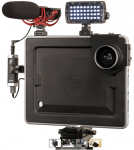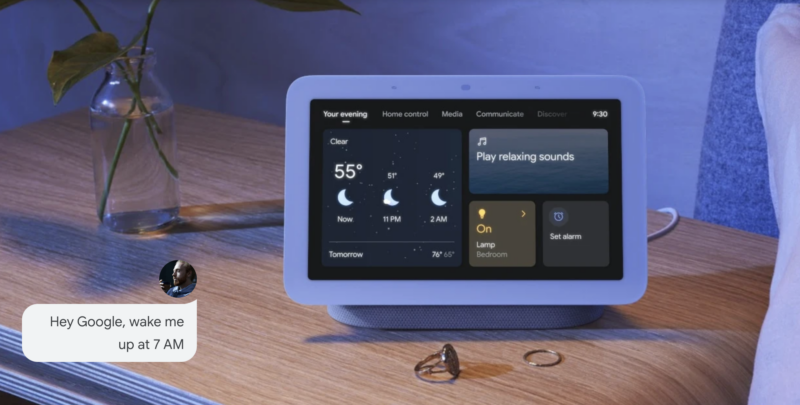The Cloud, the Church and Content Curation
Hopping down from the church stage platform, iPad in hand, the church technical director sees one lighting fixture not quite overlapping the center point upstage position. He casually selects the fixture on his iPad and drags his finger while keeping his eye on the scalloped edges of the light moving slowly, stopping only when he releases his finger from the touch surface of his tablet. He deftly saves the latest lighting cue and without any further effort, pushes this programming scene to the cloud, available for another technician who will use this same venue for a high school graduation ceremony later in the week.
Simultaneously, a bleary-eyed editor makes a final color finishing touch to a soon-to-be-played video, and with a flick of his wrist and contorted finger position, almost absently types ‘Command+S’ on his keyboard, pushing the video file to the Cloud, now available for download or streaming at any and all of their multiple campuses for playback on demand.
How The Cloud Changed Everything
 This monthly article normally focuses on the future intersection of the local church and technology, but today’s scenario isn’t in a far-off sci-fi dreamland of tech, but actual representations of what is happening week in and week out a growing number of churches embracing digital technologies that seamless sync with the cloud. It’s not quite yet an everyday occurrence in churches, so in that way this is a future-focused article. And, still, the future of tomorrow is here today and taking greater root as churches continually make updates and upgrades.
This monthly article normally focuses on the future intersection of the local church and technology, but today’s scenario isn’t in a far-off sci-fi dreamland of tech, but actual representations of what is happening week in and week out a growing number of churches embracing digital technologies that seamless sync with the cloud. It’s not quite yet an everyday occurrence in churches, so in that way this is a future-focused article. And, still, the future of tomorrow is here today and taking greater root as churches continually make updates and upgrades.
For a long, long time, the audio, video, and lighting industry focused on “the show”: a singular event of a specified duration with a sequenced orchestration of coordination. When “the show” went on the road, so too did the gear, and an industry shifted from permanent installations to portable and modular offerings. As the Internet matured, the cloud gave rise to anytime/anywhere access, once again redefining “the show” and providing entirely new levels of creative application.
Local churches, long a pseudo performance venue, saw the nearly concurrent rise of multi-site church campuses. A compelling synergy was immediately obvious, with the need to share, minimally, audio and video between multiple venues. The synchronization, however, was typically not on a shared schedule, and the advent of time-shifting programming transferred perfectly from the home DVR to professional-level servers. In the middle of it all, The Cloud was the central point, an ever-present sharing and storage point.
The Cloud Isn’t Storage, But Ultimate Access
Big Data is associated with the cloud because of massive storage of gigaflops of number crunching. This is a valuable part of storing virtually, but in the context of churches, the access to data, files, and information from nearly anywhere is of significant value.
While I’ve pointed out the clear advantage for multi-site churches, a much larger portion of the overall house of worship market can make the most out of the cloud: the small church.
Remembering that about 92 percent of all churches in North America have a weekend attendance of approximately 80 or less, volunteers are largely the workforce of the overwhelming majority of churches. Men, women and even kids are building light cues, editing videos, building presentations, setting up digital channels on a console they won’t even touch until the weekend and even creating stage plots. With full-time jobs elsewhere, this army of volunteers put in unseen hours preparing for the recurring seven-day grind, and the cloud is their shared access point that helps them do what might otherwise be impossible.
The Cloud and Content Curation
Well beyond storing flies and data drops, the cloud is perhaps best utilized as a way to curate content. The dilemma churches face when it comes to gathering new content is where to store it, what to store it on, how to organize it, how to access it quickly, and how to share their curation archives in real-time with with right people. Of course, this has been a market tapped by the professional video world as they’ve realized the volume of huge files (4K anyone?) that local storage simply cannot be handled economically.
 Part of the future opportunity for manufacturers and systems integrators alike is the creation of Web-based software tools that make it easier for volunteers and staff to capture, tag, share and archive compelling content. With the boon of high quality audio, photos and video on mobile devices, an entire mobile accessories has sprung up to assist with the capture process. From products like the Tascam HD-P2 portable professional audio recorder to the clever PadCaster all-in-one iPad capture system, capturing has never been easier. But what to do with all of that digital content?
Part of the future opportunity for manufacturers and systems integrators alike is the creation of Web-based software tools that make it easier for volunteers and staff to capture, tag, share and archive compelling content. With the boon of high quality audio, photos and video on mobile devices, an entire mobile accessories has sprung up to assist with the capture process. From products like the Tascam HD-P2 portable professional audio recorder to the clever PadCaster all-in-one iPad capture system, capturing has never been easier. But what to do with all of that digital content?
True, one can drag and drop files through Dropbox or Google Drive, but the real opportunity is to make the workflow process from capture to cataloging to curation much easier and cloud-centric. Today, it’s still a cluttered, non-seamless process of sharing and sorting various media and text files on a project by project basis. There’s plenty of room for innovation here to start with the end in mind: curation.
What Curation Means for Media
Google “content curation” and you’ll find a litany of content aggregation tools for digital marketers. This kind of curation should more accurately be described as “content aggregation,” as they help you find, organize and re-publish existing content from others on your own platforms. This is not what I mean by curation.
From a media standpoint in churches, what would be great is software that is integrated within the production workflow: capturing content, tagging it and time/timecode stamping it as it’s synced/uploaded to the cloud. Churches will want to give their production teams — staff and volunteers — easy (read: mobile) access to introduce content into an existing project workflow or a “holding area” for unfiltered content. The key is to provide a back-end tool for managing all of the users, metadata and the content itself, making the job of the content capture teams simplified while keeping the workflow clean and organized by the project leaders/managers. I’m quite sure the news networks have figured this out (or are figuring it out) through some very high-end systems (but I’m not playing in that world any longer) that do this. The trickle-down effect needs to be considered all the way down to the consumer level by manufacturers. And, frankly, systems integrators can also jump in on the action by creating this as part of a value-added service offering, much in the same way they adopted control tool sets (AMX, Crestron, etc.) to unify operation.
There’s almost no limit to what’s possible in terms of innovating with the Web as your platform. Unifying the process with a workflow perspective is the beginning of creating the new buying sequence for church leaders, where individual equipment choices are superseded by holistic content workflow and curation. Will your firm innovate in this space?
What do you think? Is Anthony’s future peek on target or not? Comment below!





